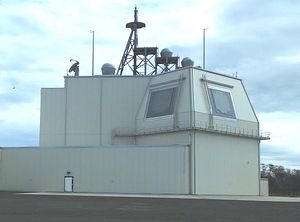U.S. defense firm Lockheed Martin Rotary and Mission Systems was awarded a cost-plus-fixed-fee modification to its foreign military sales (FMS) contract for two Aegis Ashore batteries to Japan, the U.S. Department of Defense (DoD) announced on March 5.
The new modification reportedly increases the contract value by $25.9 million, bringing the overall value of the U.S.-Japanese defense deal to $3.21 billion.
“Under this modification, the contractor will perform engineering, design support services necessary for continuation of planning efforts and risk reduction efforts required to maintain the initial operational capability schedule to support the Aegis Ashore Japan Foreign Military Sales Main Case,” the DoD said in a statement.
Japan is procuring two Aegis Ashore batteries, the land-based variant of the Aegis combat system deployed on surface combatants for defense against ballistic and cruise missiles. The U.S. Department of State approved the sale of the two missile defense system for an estimated $2.15 billion in January 2019.
The Aegis Ashore batteries, to be operated by the Japan Ground Self Defense Force (JGSDF), will be capable of firing the SM-3 Block IIA/Block IB interceptors as well as the supersonic SM-6 missile interceptors. The batteries will be stationed in Japan’s Akita and Yamaguchi prefectures.
The Japanese Ministry of Defense (MoD) also awarded a contract to Lockheed Martin for the production and delivery of two Solid State Radar (SSR) antenna sets for its two Aegis Ashore batteries in November 2019. The ministry selected the SSR in July 2018 over Raytheon’s SPY-6 radar system “due to the SSR’s lower lifecycle costs, better overall system performance including more sophisticated target discrimination capabilities and cheaper acquisition and operating costs in comparison to the SPY-6,” I reported at the time. I also cited a possible other reason for the decision:
One of the most likely explanations why Japan picked the SSR over SPY-6 is the former’s earlier availability. The SPY-6 will likely not be ready for export before 2024 or 2025.
Yet, I also noted the following caveat:
(…) Japan wants to deploy both Aegis Ashore batteries by 2023, although the July 30 MoD statement noted that it will take six years from the signing of the contract to the operational deployment of the two batteries, which could mean that the batteries might not be operational until 2024 or 2025 after all.
The Aegis Ashore batteries are slated to deploy alongside the JGSDF’s PAC-3 Patriot batteries, capable of engaging short- and medium-range ballistic missiles in their terminal phase, and the Japan Maritime Self-Defense Force’s (JMSDF) fleet of Aegis-equipped guided-missile destroyers.
“The combat system for Aegis Ashore Japan will be compatible with the country’s current Aegis naval fleet for full interoperability,” Lockheed Martin said in a November 2019 statement. “As the threat environment evolves, Aegis Ashore Japan will be updated from the same Common Source Library (CSL) of software updates that all Aegis assets utilize.”
Japan’s newest guided-missile destroyers are fitted with the Aegis Baseline J7 combat system, the Japanese equivalent to the U.S. Navy’s Baseline 9/BMD 5.1 standard Aegis combat system.
































